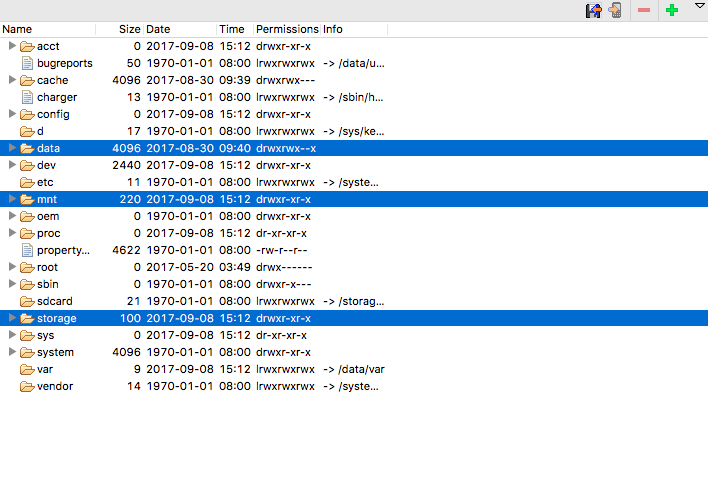Android File存储
Android系统为我们提供了多种途径可以实现持久化储存,本专题主要讨论常用5种存储方案之一的File存储。
基本概念
内存(memory)
内部存储(InternalStorage)
外部存储(ExternalStorage)
首先我们得搞清楚这三个概念,内存,我们在英文中称作memory,内部存储,我们称为InternalStorage,外部存储我们称为ExternalStorage。
Android系统提供的持久化方案大致有如下五种
- 网络
- File
- Shared Preference
- ContentProvider
- SQLite
其中网络、Shared Preference、ContentProvider、SQLite都是我们经常使用的,但不是我们本专题的的重点,本专题的重点是File存储,File存储在我们日常开发中经常使用(显示的或隐式的),但也是我们比较容易忽略的知识点,Android很多框架都是基于它实现的,所以掌握好File存储对学习Android系统有很大帮助。
Android 文件结构

上图就是Android文件的结构图了,这里给大家介绍一下/data、/mnt、/storage这三个文件夹(因为这涉及到我们接下来的内容),/data这个文件夹下中有一个app文件夹是用来存放我们安装应用的apk文件的,同时下面还有一个data目录这个就是我们的内部存储空间了(sharedpreference、数据库文件等都是存在这里的),不同的应用用以包命名的文件夹作区分。mnt和storage就是我们的外部存储空间了,mnt下只是一个storage的链接,真正空间位置还是storage。
内部存储和外部存储
在进入主题之前我得明白,所有 Android 设备都有两个文件存储区域:“内部”和“外部”存储。这些名称在 Android 早期产生,当时大多数设备都提供内置的非易失性内存(内部存储),以及移动存储介质,比如微型 SD 卡(外部存储)。一些设备将永久性存储空间划分为“内部”和“外部”分区,即便没有移动存储介质,也始终有两个存储空间,并且无论外部存储设备是否可移动,API 的行为均一致。下面我们来看一下相对于程序来说它们各自有什么区别呢?
内部存储:什么是内部存储呢?可以这样理解,除了应用程序本身其他程序无法读取(Root情况不考虑),同时还具有如下性质:
- 它始终可用(在足够空间下)
- 当用户卸载您的应用时,系统会从内部存储中移除您的应用的所有文件
外部存储
- 它并非始终可用,因为用户可采用 USB - 存储设备的形式装载外部存储,并在某些情况下会从设备中将其移除。
- 它是全局可读的,因此此处保存的文件可能不受您控制地被读取。
- 当用户卸载您的应用时,只有在您通过 getExternalFilesDir() 将您的应用的文件保存在目录中时,系统才会从此处移除您的应用的文件。
常见使用内部存储方法
public class Context{
/**
* 作用:可以方便地再手机中创建文件,并返回文件输出流,用于对文件做写入操作。
*
* @param name 用于指定文件名称,不能包含路径分隔符“/”,如果文件不存在,Android会自动创建它。
* 创建的文件保存在/data/data/<package name>/files/目录中
* @param mode mode取值:
* MODE_APPEND 私有(只有创建此文件的程序能够使用,其他应用程序不能访问),在原有内容基础上增加数据
* MODE_PRIVATE 私有,每次打开文件都会覆盖原来的内容
* @return
*/
public abstract FileOutputStream openFileOutput(String name, int mode);
public abstract File getFilesDir(); //获取文件系统的绝对路径:/data/data/<package name>/files/
String[] fileList (); //当前应用内部存储路径下的所有文件名
public abstract FileInputStream openFileInput(String name);//与openFileOutput对应
public abstract File getDir(String name, int mode);//在应用程序的数据文件下获取或创建name对应的子目录
public abstract File getCacheDir();//方法可以获得当前的手机自带的存储空间中的当前包文件的路径:/data/data/<package name>/cache/
...
}
常见使用外部部存储方法
public class Context{
/**
*
* @param type The type of files directory to return. May be {@code null}
* for the root of the files directory or one of the following
* constants for a subdirectory:
* {@link android.os.Environment#DIRECTORY_MUSIC}, //mnt/sdcard/android/data/包名/files/music
* {@link android.os.Environment#DIRECTORY_PODCASTS},
* {@link android.os.Environment#DIRECTORY_RINGTONES},
* {@link android.os.Environment#DIRECTORY_ALARMS},
* {@link android.os.Environment#DIRECTORY_NOTIFICATIONS},
* {@link android.os.Environment#DIRECTORY_PICTURES}, or
* {@link android.os.Environment#DIRECTORY_MOVIES}.
*/
public abstract File getExternalFilesDir(@Nullable String type);
public abstract File getExternalCacheDir();//mnt/sdcard/android/data/包名/cache/
...
}
public class Environment{
public static String getExternalStorageState();//获取shared/external storage的状态
public static File getExternalStorageDirectory();//返回mnt/sdcard/
...
}
Context和Environment都可以用来操作外部存储空间,那么这两这有什么区别呢?一般Context所操作的是私有空间即:/mnt/sdcard/android/data/包名/,而Environment操作的是共有空间:/mnt/sdcard/。
最后福利
public class ExternalStorageHelper {
// 判断SD卡是否被挂载
public static boolean isSDCardMounted() {
// return Environment.getExternalStorageState().equals("mounted");
return Environment.getExternalStorageState().equals(
Environment.MEDIA_MOUNTED);
}
// 获取SD卡的根目录
public static String getSDCardBaseDir() {
if (isSDCardMounted()) {
return Environment.getExternalStorageDirectory().getAbsolutePath();
}
return null;
}
// 获取SD卡的完整空间大小,返回MB
public static long getSDCardSize() {
if (isSDCardMounted()) {
StatFs fs = new StatFs(getSDCardBaseDir());
long count = fs.getBlockCountLong();
long size = fs.getBlockSizeLong();
return count * size / 1024 / 1024;
}
return 0;
}
// 获取SD卡的剩余空间大小
public static long getSDCardFreeSize() {
if (isSDCardMounted()) {
StatFs fs = new StatFs(getSDCardBaseDir());
long count = fs.getFreeBlocksLong();
long size = fs.getBlockSizeLong();
return count * size / 1024 / 1024;
}
return 0;
}
// 获取SD卡的可用空间大小
public static long getSDCardAvailableSize() {
if (isSDCardMounted()) {
StatFs fs = new StatFs(getSDCardBaseDir());
long count = fs.getAvailableBlocksLong();
long size = fs.getBlockSizeLong();
return count * size / 1024 / 1024;
}
return 0;
}
// 往SD卡的公有目录下保存文件
public static boolean saveFileToSDCardPublicDir(byte[] data, String type,
String fileName) {
BufferedOutputStream bos = null;
if (isSDCardMounted()) {
File file = Environment.getExternalStoragePublicDirectory(type);
try {
bos = new BufferedOutputStream(new FileOutputStream(new File(
file, fileName)));
bos.write(data);
bos.flush();
return true;
} catch (Exception e) {
e.printStackTrace();
} finally {
try {
bos.close();
} catch (IOException e) {
// TODO Auto-generated catch block
e.printStackTrace();
}
}
}
return false;
}
// 往SD卡的自定义目录下保存文件
public static boolean saveFileToSDCardCustomDir(byte[] data, String dir,
String fileName) {
BufferedOutputStream bos = null;
if (isSDCardMounted()) {
File file = new File(getSDCardBaseDir() + File.separator + dir);
if (!file.exists()) {
file.mkdirs();// 递归创建自定义目录
}
try {
bos = new BufferedOutputStream(new FileOutputStream(new File(
file, fileName)));
bos.write(data);
bos.flush();
return true;
} catch (Exception e) {
e.printStackTrace();
} finally {
try {
bos.close();
} catch (IOException e) {
// TODO Auto-generated catch block
e.printStackTrace();
}
}
}
return false;
}
// 往SD卡的私有Files目录下保存文件
public static boolean saveFileToSDCardPrivateFilesDir(byte[] data,
String type, String fileName, Context context) {
BufferedOutputStream bos = null;
if (isSDCardMounted()) {
File file = context.getExternalFilesDir(type);
try {
bos = new BufferedOutputStream(new FileOutputStream(new File(
file, fileName)));
bos.write(data);
bos.flush();
return true;
} catch (Exception e) {
e.printStackTrace();
} finally {
try {
bos.close();
} catch (IOException e) {
// TODO Auto-generated catch block
e.printStackTrace();
}
}
}
return false;
}
// 往SD卡的私有Cache目录下保存文件
public static boolean saveFileToSDCardPrivateCacheDir(byte[] data,
String fileName, Context context) {
BufferedOutputStream bos = null;
if (isSDCardMounted()) {
File file = context.getExternalCacheDir();
try {
bos = new BufferedOutputStream(new FileOutputStream(new File(
file, fileName)));
bos.write(data);
bos.flush();
return true;
} catch (Exception e) {
e.printStackTrace();
} finally {
try {
bos.close();
} catch (IOException e) {
// TODO Auto-generated catch block
e.printStackTrace();
}
}
}
return false;
}
// 保存bitmap图片到SDCard的私有Cache目录
public static boolean saveBitmapToSDCardPrivateCacheDir(Bitmap bitmap,
String fileName, Context context) {
if (isSDCardMounted()) {
BufferedOutputStream bos = null;
// 获取私有的Cache缓存目录
File file = context.getExternalCacheDir();
try {
bos = new BufferedOutputStream(new FileOutputStream(new File(
file, fileName)));
if (fileName != null
&& (fileName.contains(".png") || fileName
.contains(".PNG"))) {
bitmap.compress(Bitmap.CompressFormat.PNG, 100, bos);
} else {
bitmap.compress(Bitmap.CompressFormat.JPEG, 100, bos);
}
bos.flush();
} catch (Exception e) {
e.printStackTrace();
} finally {
if (bos != null) {
try {
bos.close();
} catch (IOException e) {
e.printStackTrace();
}
}
}
return true;
} else {
return false;
}
}
// 从SD卡获取文件
public static byte[] loadFileFromSDCard(String fileDir) {
BufferedInputStream bis = null;
ByteArrayOutputStream baos = new ByteArrayOutputStream();
try {
bis = new BufferedInputStream(
new FileInputStream(new File(fileDir)));
byte[] buffer = new byte[8 * 1024];
int c = 0;
while ((c = bis.read(buffer)) != -1) {
baos.write(buffer, 0, c);
baos.flush();
}
return baos.toByteArray();
} catch (Exception e) {
e.printStackTrace();
} finally {
try {
baos.close();
bis.close();
} catch (IOException e) {
e.printStackTrace();
}
}
return null;
}
// 从SDCard中寻找指定目录下的文件,返回Bitmap
public Bitmap loadBitmapFromSDCard(String filePath) {
byte[] data = loadFileFromSDCard(filePath);
if (data != null) {
Bitmap bm = BitmapFactory.decodeByteArray(data, 0, data.length);
if (bm != null) {
return bm;
}
}
return null;
}
// 获取SD卡公有目录的路径
public static String getSDCardPublicDir(String type) {
return Environment.getExternalStoragePublicDirectory(type).toString();
}
// 获取SD卡私有Cache目录的路径
public static String getSDCardPrivateCacheDir(Context context) {
return context.getExternalCacheDir().getAbsolutePath();
}
// 获取SD卡私有Files目录的路径
public static String getSDCardPrivateFilesDir(Context context, String type) {
return context.getExternalFilesDir(type).getAbsolutePath();
}
public static boolean isFileExist(String filePath) {
File file = new File(filePath);
return file.isFile();
}
// 从sdcard中删除文件
public static boolean removeFileFromSDCard(String filePath) {
File file = new File(filePath);
if (file.exists()) {
try {
file.delete();
return true;
} catch (Exception e) {
return false;
}
} else {
return false;
}
}
}